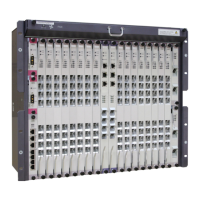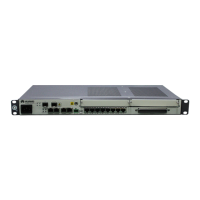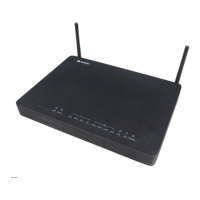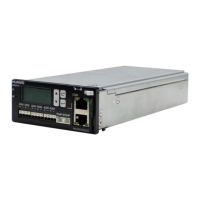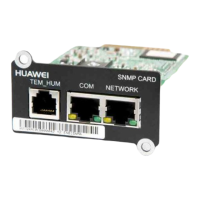Typical
Configura
tion
Static
power
consum
ption
Maxim
um
power
consum
ption
Typica
l
power
consu
mption
Board configuration
GPON
(H801SCU
H
+H805GPF
D)
648.84 1178.55 913.695 H801SCUH*2+H801X2CS*2+H801CIT
D+H801PRTE*2+H801FCBI
+H805GPFD*16
NOTE
The power consumption of the subrack is tested in the following conditions:
l Working voltage: -53.5 V DC.
l Ambient temperature: 25 °C.
l Static power consumption: All ports do not carry any loads. Specifically, users under POTS ports
hang up phones, xDSL ports are deactivated, and optical modules are not installed on optical ports
l Maximum power consumption: All ports fully carry loads. However, only 25% users under POTS
ports concurrently pick up phones and the feeding current is 20 mA.
l Typical power consumption: half of the total value of static power consumption and maximum
power consumption.
l The preceding table lists power consumption under typical configuration. For power consumption
under other configurations, use Access Network Hardware Configuration Tool.
l In the case of Access device, power consumption is generally transformed into heat consumption.
Hence, heat consumption (BTU/h) and power consumption (W) can be converted to each other in
the formula: 1 BTU/h = 0.2931 W.
2.1.3 Configuration
The ETSI service subrack provides 16 slots for service boards, two slots for control boards,
two slots for power boards, one for universal interface board and tow for upstream interface
boards. This topic lists the types of boards supported by the ETSI service subrack and the slot
restriction.
Configuration
H801MABC, H802MABC and H803MABC are the backplane supported by the ETSI service
subrack. H801MABC does not support the Vectoring feature, H802MABC and H803MABC
support the Vectoring feature.
SmartAX MA5600T/MA5603T/MA5608T Multi-service
Access Module
Hardware Description
2 Subrack and Chassis
Issue 24 (2018-07-30) Huawei Proprietary and Confidential
Copyright © Huawei Technologies Co., Ltd.
73

